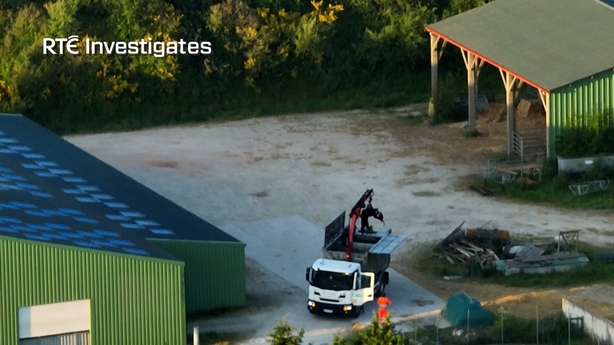For months, RTÉ Investigates has been looking into Ireland's dairy boom. The boom began after restrictions on producing milk were lifted in 2015.
The investigation has uncovered animal welfare issues at marts and breaches of regulations on the transport of animals in mainland Europe.
Strict guidelines on animal welfare appear to be routinely flouted at many Irish marts.
Prime Time presenter Fran McNulty tracked what a truck load of Irish bull calves experienced on their export journey.
From Cabin 679 you can clearly hear calves bawling from below deck.
Thirteen hours since our ferry set sail from Rosslare, we’re now in the calm waters of the English Channel. It’s longer still since they were loaded onto a truck in a livestock yard in Co Wicklow.
For the unweaned calves it’s a long time without mother’s milk.
The journey to their final destination is the same one that tens of thousands of calves have taken this year. The constant noise they are making is the sound of hunger.
The calves cannot be fed aboard the ship, there are no feeding facilities apart from water faucets on the trucks.

The sailing takes more than eighteen-and-a-half hours - add journey time to port, preparations to board, and disembark the ferry and the animals could easily be facing in excess of 21 hours without milk.
There are anywhere between 2,000 and 3,000 calves on this sailing. From the outdoor decks of the ship you can smell the animals on the air. The sound of them can be heard clearly over the humongous roaring engines of the ferry.
The calves are all male. They are a by-product of Ireland’s burgeoning dairy industry. The expansion of dairy means there are more calves being born every year now than at any time in the past, more than 1.5m per year.
Male calves do not provide milk, nor do they fatten well for beef, unless they are cross bred with beef breeds. Mainland Europe has become the dumping ground for what are seen as valueless animals.
They are so valueless that over the past number of months we have witnessed scenes at Irish marts in which customers were literally offered poor quality calves for free and wouldn’t take them.
The veal industry in Europe benefits from the boom in births of Irish calves.
During peak calving season when the marts are packed with calves, prices fall and animals can change hands for next to nothing at marts all over the country from where they are shipped to veal farms in Holland, Spain, Italy and lately in bigger numbers to Poland and Romania.
Poland’s veal production is on the rise, many in the calf export business say it is the big new growth market. The export figures back that up, the number of calves going to Poland has jumped 300%.
During the sailing to France, we made several visits to Deck 4 of the ferry to check on the animals. We saw the truck we filmed being loaded with young bull calves at a large lairage in rural Co Wicklow earlier in the day.
On arrival in France, the truck leaves the ferry and starts to head inland.
Two young backpackers stand stunned as the sound of hundreds of calves bawling from the inside of livestock carriers echoes across the port. "What is this?" asks a clearly shocked man.
The driver takes the calves a short distance to a large yard with sheds, called a lairage.
It is one of two facilities close to Cherbourg Port where virtually all Irish calves stop off to be fed milk replacer and rest up for a mandatory 13 hours.
This lairage at Tollevast and another nearby at Pignet have, in the past, both found themselves in the spotlight when images of disturbing animal welfare were captured by French animal welfare campaigners L214. The latest incident was in March of this year, when Pignet was closed by French authorities.
The truck driver beds down for the night. At this point we don’t know our destination. It could be Holland, Romania, Poland or Spain.
As we wake, the countryside surrounding the Qualivia Lairage in Tollevast is draped in morning fog. We hear a vehicle approach, it is an animal collection service. It scoops up two dead Irish calves, not from the truck we’ve followed but from another of the six Irish trucks that arrived the evening before.
As the vehicle pulls away with the dead animals, in the distance we can hear the rest of the calves being rounded up to be loaded onto the waiting trucks. Our truck pulls out just after 10.20am, within minutes we’re on the motorway.

It is three hours later before the driver stops and takes a 32 minute break at a lay-by beside a toll plaza. There are two more stops before another 29 minute break. By then we are nine hours into the journey.
When the driver pulls away after less than half an hour, he breaches EU regulations on animal feed and rest times. Under the rules, after nine hours on the road, the animals must be rested and fed for at least an hour, before another nine hours on the road, at which point they must rest up for 24 hours.
During each stop, there are no checks made on the animals by the driver. Several times, when he is away from the truck, we check on them.
After nine hours many of them look tired and weary, some lie on the floor, others stand. Faeces covers the face of one of the smallest calves, which peeks out at us as we film the interior of the transport truck during one of the brief roadside stops.
At this point we have driven south past Paris towards the Pyrenees, and onwards for Toulouse. We now know we are most likely heading for Spain.
Eighteen-and-a-half hours later that is confirmed. North of Barcelona we pull into an industrial estate, the Irish truck slowly winds its way up a steep hill through a motorway underpass and into a farm which borders the industrial estate. It is 4:57am, the farm is shrouded in darkness.
For the calves their two-and-a-half day journey is over.
The farm is unmanned, the driver unloads the calves, singlehandedly. They run eagerly into the brightly-lit shed, it is still dark outside.
On the horizon you can see the first glimpse of the dawn. For just the second time since they left Wicklow, they will drink some milk.
Under EU regulations they should have been rested and fed for one hour mid-way through the journey.
As they bed in, we see a Dutch-registered livestock truck pull into the yard. The driver’s first job is to unload a dead calf, which he puts into a pen beside the off-loading ramp.
As hundreds of calves pour off the truck many stop and look into the pen at the dead calf, before moving into the sheds. Hungry and tired, they are amongst close to 600 calves delivered to the farm in the space of 15 minutes.
The company that owns the truck we followed has said it is conducting an internal investigation into the journey which we brought to their attention. It also insists it takes the regulations on driver safety and animal welfare 'extremely seriously.’
Many of the calves exported to the continent for the multi-billion euro veal trade are sourced at Irish marts. Many are sold cheap, the large volumes of calves come as a tsunami over the Spring calving season.
During our investigation, we have seen calves sold for as little as €5. More than once, small, spindly calves were led into the auction ring and no one was willing to buy them, even when the price dropped to €1.
In one instance a tiny bull calf walks around the ring, no one is bidding so the auctioneer asks "anyone want to take him as a present?"
There are no takers and the mart handler leads the calf out of the ring. Valueless and unwanted, an indication of oversupply and bad breeding.
It is so called ‘extreme dairy breeds’ that are the problem. Often they are Jersey cross cattle that are good for milk production but valueless in terms of beef production.
Their lack of value is reflected in how the animals are sometimes treated. We’ve seen calves kicked, slapped and hit with sticks. The use of sticks on calves is not permitted by law.

More worryingly still, several times we’ve seen calves thrown from the back of trailers. In one case a mart worker flung two calves through the air. The young calves staggered and regained their feet before being moved towards the mart ring for sale.
When we contacted the marts, some condemned the behaviour. Others didn’t respond.
A spokesperson for the group that represents them, the Irish Co-Operative Organisation Society, described much of the footage we have secured in marts as "illegal."
Those responsible should, they say, face the "full rigour" of the law.
RTÉ Investigates: ‘Milking It: Dairy’s Dirty Secret’ broadcasts at 9.30pm on Monday July 10 on RTÉ One.





